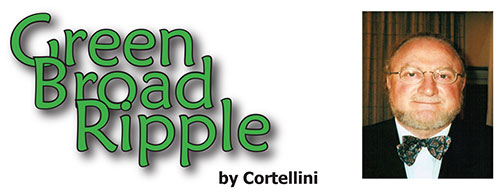
|
Broad Ripple Random Ripplings

The news from Broad Ripple
Brought to you by The Broad Ripple Gazette
(Delivering the news since 2004, every two weeks)

|
| Brought to you by: |

|

|

|

|

|

|
Converted from paper version of the Broad Ripple Gazette (v04n08)
Green Broad Ripple - Green Road Trip Report - by Cortellini
posted: Apr. 20, 2007

Green Road Trip Report
I am writing this article just having returned from a sixteen day excursion to Italy in search of all things Green. We did so because, after all, Green is a global issue. Patty and I visited small towns in the regions of Tuscany, Umbria, and le Marche and spent a week (Holy Week) in Roma. We drove on the high-ways, traveled by train, and took the bus. We departed with expectations and returned with a new awareness.
The major industries in Italy are precision machinery, motor vehicles, chemicals, pharmaceuticals, electric goods, fashion, and clothing. Most important, however, is food and tourism - two elements that are inextricably intertwined in the history and culture of this nation of 55 million. Living on a landmass slightly larger than Arizona, Italians are perpetually adapting the lessons learned over 3,000 years to the demands of our modern times. History is everywhere in Italy. Antiquity is layered upon antiquity. This has engendered a respect and even a love for the historic and the authentic. Buildings are not disposed of but reused - even those that are hundreds of years old. There is constant effort in restoration. Everywhere restoration efforts are conspicuous and everywhere people come from all over the world to experience the history. The income from tourism, coupled with a deep and genuine regard for the past, makes Italy very Green in the reuse of building resources and, at the same time, promotes quality and permanence in new construction.
Plant vines for your children, olive trees for your grandchildren. So the saying goes among the 5% of the population now involved in Italian agriculture. Grape and olive are the predominant crops. Both grow slowly and transcend human generations. They can be seen growing on hillsides all over Italy - cultivated much the same way for centuries. In the mild Italian climate, farmers also produce a large variety of fruits, grains, beans and vegetables. Meats tend to be lean and much is processed into the form of cured products such as prosciutto and salami. A wide variety of cheeses are produced from cow, sheep, goat, and water buffalo milk. As the sea is always nearby, the varied seafood is always fresh. The long history of city states, along with the large variety of soil and climate conditions, has engendered a strong sense of regional identity and localized cuisine traditions that attract many visitors for the gastronomic experience alone. It is not surprising, then, that Italy, along with art and antiquity, considers food (cibo) a national treasure. Naturally organic, locally produced and celebrated, and cultivated with time-tested methods, Italian food is appreciated for its diversity and superior quality even by those who are unaware of its Green nature.
Italians seem to be conservative in their use of utilities. All the bathrooms are fitted with low flush toilets and bidets, and we observed instances of rainwater harvesting. At our villa in Tuscany, we could only plug in one kitchen appliance at a time. The high cost of utilities is certainly a contributor to conservation. Train and bus services seemed to work well, and were convenient and affordable in small and large cities alike. Driving, although it always takes some getting used to, was a manageable adventure everywhere but Roma.
Roma is an enigma. It is a marvelous walkable city choked with traffic - a perpetual conflict between the vehicular and the pedestrian. Walking is an exercise in survival. In fact, if you do a little Googling, you will find websites dedicated to giving tips as to how to cross the street in Rome. Driving is an exasperating and stressful collision avoidance endeavor, and it takes a miracle to find a parking spot. Granted, we saw Roma at its busiest, yet how can it be that the Italians, who are so aware of their cultural history, be so indifferent to this glaring contradiction? Perhaps it is because things may be a little out of control. Many Romans think that while the official population of Rome is 3.5 million, there are at least that many illegals. Perhaps it is because 90% of the people that work in Rome need to commute, rent being prohibitively expensive. Perhaps it is because 100% of the Italians have a love affair with their autos and scooters. Or perhaps it is a twist of irony that their attachment to the past encumbers their ability to invent a new future. It is this last point that made me realize that if the world does go Green, it will do so following the leadership of the land of possibilities - Broad Ripple.
Cortellini is a licensed architect in the states of Indiana and Arizona. He holds a BFA from Indiana University Herron School of Art. He has taught architectural technology at the college level at several universities and has pursued independent artistic endeavors. His architectural practice has focused on residential and small commercial projects. He has recently committed his practice to designing Green buildings, is a member of the US Green Building Council and is a LEED Accredited Professional. Send questions/comments to cortellini@BroadRippleGazette.com
cortellini@broadripplegazette.com

|

|

|
| Brought to you by: |

|

|

|
| Brought to you by: |

|

|

|


